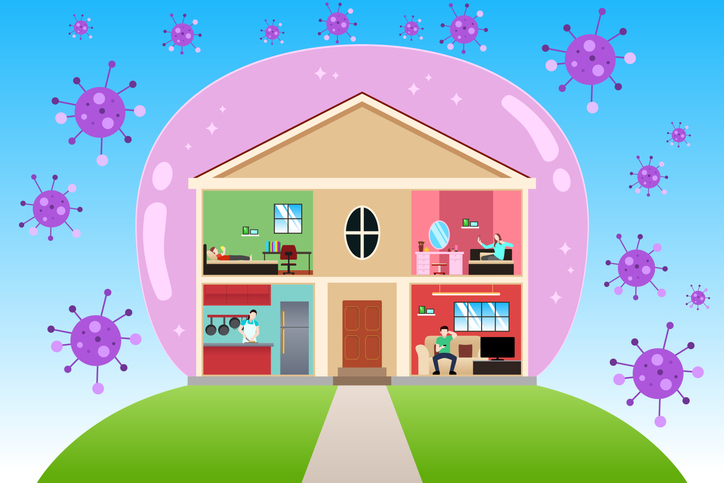Ban Dirty Indoor Air to Stay Safe During the Pandemic

Over the past few weeks, we have learned much more about the new novel coronavirus and the disease it causes, COVID-19.
But we still don't know enough. Right now it seems as if every day brings new information, some of it confusing or even conflicting.
A few weeks ago, the “hot topic” was face masks and gloves - do they help or don't they? Now the big debate revolves around air quality. Does it matter?
Thankfully, on this topic, we have solid data to support a definitive answer - YES.
Dirty air and coronaviruses are clearly linked. The more polluted the air we breathe, the more risk we bear of contracting a serious or fatal case of COVID-19.
In this post, we are going to tell you what to do to clean up your indoor air ASAP.
Dirty Air Leads to Increased COVID-19 Deaths
Recently, a team of Harvard University researchers convened to evaluate air quality throughout the United States. The study extended to cover 98 percent of all populated areas.
Study data highlighted a clear link between airborne concentration of fine particulate pollutants (PM2.5) and increased risk of death from COVID-19.
Specifically, for every one microgram increase in airborne PM2.5, the risk of COVID-19 fatalities increased by 8 percent.
This data sounds rather dry and impersonal. It isn't.
Researchers estimated that if the area of Manhattan in New York City had been able to reduce its airborne concentration of PM2.5 by just one microgram over the last two decades, it would have saved 248 lives that have now been lost due to COVID-19.
Why is this relevant to us here in Ontario? Because areas of our own province have a very similar level of air toxicity to what is present in Manhattan.
Industrial Toxins Polluting Ontarians' Air Supply
A research study published just a few months ago highlights serious air quality issues unfolding in areas of Ontario and Prince Edward Island.
One of the biggest concerns is the concentration of benzene, a liquid chemical that is both naturally occurring and produced due to petrochemical refining and manufacturing processes.
Benzene exposure is linked to a normally rare form of leukemia. Three times more Canadians living in affected areas have developed this cancer than anywhere else in Canada.
Benzene is not a PM2.5 toxin. But yet another research study proves that exposure to both PM2.5 particulates (many of which are also linked to operations within the petrochemical industry) and benzene can raise the risk of birth defects as well as serious illness.
What does all of this scary information have to do with you?
Simply put, it is vital to know what is polluting your air before you can take action to clean it up!
3 Key Steps to Take to Clean, Filter, and Purify Your Indoor Air
While COVID-19 is definitely getting the lion's share of the spotlight at the moment, it is far from the only serious disease that can be caused or worsened by exposure to dirty air.
By taking the steps we are about to share here, you protect yourself and your family from not just the coronavirus but also from many other health risks both minor and major.
1. Ventilate your indoor space
Ventilation is the process by which your indoor air supply is continuously refreshed.
By simply sitting in your space and breathing, the air becomes depleted of oxygen and rich in carbon dioxide.
Many activities you do in your home can add other toxins into the air. Do you use air fresheners, perfumes, or colognes, commercial cleaning products, wood or gas-fired stoves or fireplaces, or tobacco products?
All of these can release both PM2.5 particulates and volatile organic compounds such as benzene into your indoor air.
Scary, right?! What can you do about this?
A neat appliance called a heat recovery ventilator can send your now-toxified, stale, oxygen-poor air back outside.
At the same time, ventilation pulls in fresh, oxygen-rich outdoor air into your space, removes excess humidity, and works with any indoor air quality aids to filter and purify it.
Ventilation with a heat recovery ventilator ensures that you always have a ready, steady supply of clean, fresh indoor air to breathe. As a perk, HRVs can also recycle otherwise wasted energy to lower your power bills.
2. Filter your indoor air
Solid PM2.5 particulates are incredibly tiny. Regular furnace filters are no match for these microscopic floating toxins.
The only filter that is dense enough to trap and remove PM2.5 particulates from your indoor air is the HEPA air filter. HEPA (high efficiency particulate air) filters were first invented during World War II to protect scientists from inhaling radioactive particulates.
Today's HEPA filters are even better and can trap micro-particulates as small as 1/100th the width of a single human hair.
HEPA filters offer a higher grade of filtration than what N95 masks can provide. Whereas N95 masks can trap up to 95 percent of micro-particulates, HEPA filters can trap up to 99.97 percent of the same.
3. Purify your indoor air
The last step you need to take is the most important for combatting the coronavirus directly. This is because the coronavirus is a liquid airborne pathogen.
Liquid and gaseous airborne pathogens are less easily captured even by a HEPA filtration system. For this, you need an ultraviolet air purifier.
Ultraviolet air purifiers use synthetic UV-C, the most powerful ultraviolet light band, to damage the thin outer membrane of liquid and gaseous viruses, volatile organic compounds, and other toxins. Once irradiated by UV light, these particles cannot cause harm.
Get in Touch
HVAC, electrical, and plumbing have been deemed essential services in Ontario. Our team is working remotely, but we are still here to serve you.
Please read our updated contact guide to learn how we can help you and your family stay safe and healthy.
Give us a call at 613-967-1066 or visit us online.

